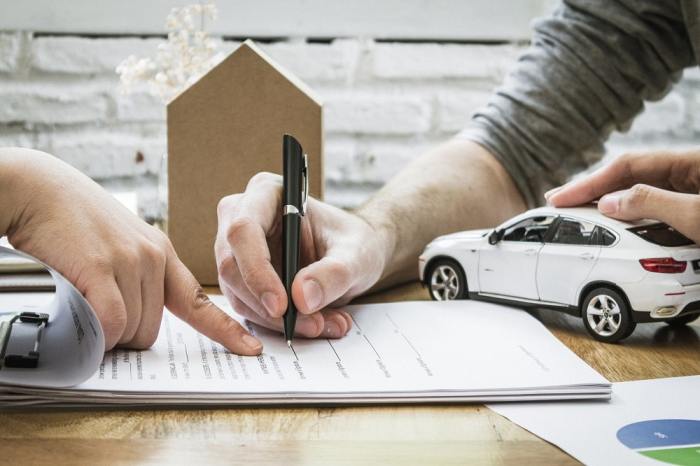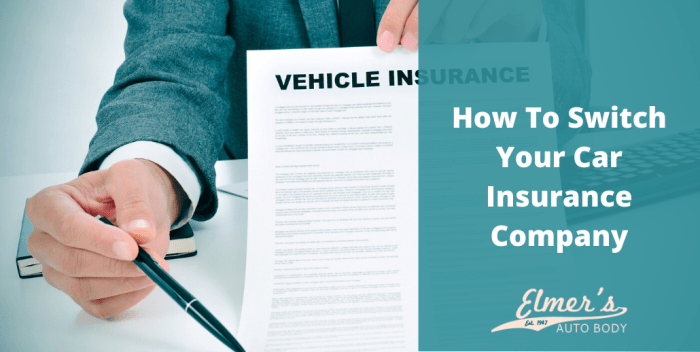How to switch car insurance companies – Switching car insurance companies can be a daunting task, but it doesn’t have to be. Here’s a comprehensive guide to help you navigate the process seamlessly, ensuring you get the best coverage at the most affordable price.
To begin your journey, you’ll need to research and compare different insurance providers. Consider factors like coverage options, premiums, and customer ratings to make an informed decision.
Research and Compare Insurance Providers: How To Switch Car Insurance Companies

Before switching insurance companies, it’s crucial to conduct thorough research and compare different providers to find the best fit for your needs and budget. Consider factors such as coverage options, premiums, and customer ratings to make an informed decision.
The following table compares several reputable insurance companies based on these key factors:
| Provider | Coverage Options | Premiums | Customer Ratings |
|---|---|---|---|
| Company A | Comprehensive coverage options, including liability, collision, and uninsured motorist protection | Competitive premiums with discounts for multiple policies and safe driving | High customer satisfaction ratings for quick claims processing and excellent customer service |
| Company B | Tailored coverage options to meet specific needs, such as high-value vehicles or teenage drivers | Slightly higher premiums, but offers additional benefits like roadside assistance and rental car reimbursement | Moderate customer ratings due to occasional delays in claims processing |
| Company C | Basic coverage options at affordable premiums | Lower premiums, but limited coverage and higher deductibles | Mixed customer reviews, with some praising the low cost and others complaining about slow response times |
Coverage Options
Coverage options vary between insurance companies, so it’s important to understand the specific coverages you need before making a decision. Common coverage options include:
- Liability coverage: Protects you from financial responsibility in case of an accident where you are at fault.
- Collision coverage: Covers damage to your own vehicle in case of a collision with another vehicle or object.
- Comprehensive coverage: Provides protection against non-collision events, such as theft, vandalism, or natural disasters.
- Uninsured/underinsured motorist protection: Covers you if you are involved in an accident with a driver who is uninsured or underinsured.
Premiums
Premiums are the monthly or annual payments you make to your insurance company. Premiums vary based on factors such as your age, driving history, and the type of vehicle you drive. It’s important to compare premiums from different companies to find the best deal.
Customer Ratings
Customer ratings can provide valuable insights into the quality of service and claims processing of an insurance company. Look for companies with high customer satisfaction ratings to ensure you receive reliable and efficient service when you need it most.
While switching car insurance companies, it’s crucial to understand the nuances of your coverage. Uninsured motorist coverage protects you financially in case of an accident caused by an uninsured driver. By ensuring you have adequate coverage, you can safeguard yourself from potential financial burdens.
As you compare policies, remember to prioritize your specific needs and budget to find the best fit for your driving experience.
Gather Necessary Information
Switching car insurance companies requires meticulous preparation. To ensure a smooth transition, it’s crucial to gather all necessary documents and information upfront. This will help streamline the process and avoid any potential delays or complications.
If you’re thinking about switching car insurance companies, it’s important to do your research and compare quotes from multiple providers. You’ll also want to make sure you understand the different types of coverage available. Comprehensive car insurance , for example, provides coverage for damage to your car caused by accidents, theft, vandalism, and other events.
It’s more expensive than liability-only insurance, but it can provide peace of mind knowing that you’re covered in the event of an accident.
Documents and Information Checklist
Here’s a comprehensive checklist to guide you:
- Driver’s license:Proof of identity and driving privileges.
- Vehicle registration:Proof of vehicle ownership and insurance eligibility.
- Proof of previous insurance:Evidence of your current or recent insurance coverage.
- Vehicle details:Make, model, year, VIN, and mileage.
- Driving history:Details of any traffic violations or accidents.
- Additional drivers:Names and driver’s license information for any other drivers covered under the policy.
- Personal information:Address, phone number, email address.
Importance of Accurate Information
Providing accurate and up-to-date information is paramount. Incomplete or incorrect details can lead to delays, incorrect policy coverage, or even denied claims. By ensuring the accuracy of your information, you safeguard your financial interests and protect yourself from potential disputes.
Switching car insurance companies can be a breeze, but understanding the types of coverage you need is key. If you’re unsure about liability car insurance, check out this helpful guide . It explains the basics, so you can make an informed decision when comparing policies.
Once you’ve got that sorted, switching providers becomes a cinch.
Cancel Existing Policy

Terminating your existing insurance coverage is crucial before switching to a new provider. This step ensures a seamless transition and prevents overlapping policies and potential financial implications.
When considering a change in car insurance providers, it’s prudent to research ways to reduce premiums. Consult How to get cheap car insurance for guidance on cost-saving measures. Once you’ve identified strategies for lowering your expenses, proceed with the steps to switch car insurance companies and secure the most advantageous coverage for your needs.
Follow these steps to cancel your current insurance policy:
Notice Period
Check your policy documents or contact your insurer to determine the required notice period for policy cancellation. Typically, it ranges from 30 to 60 days.
Contact Insurer
Reach out to your insurer via phone, email, or in writing to express your intention to cancel the policy. Provide your policy number and effective cancellation date.
Cancellation Fees
Be aware that some insurers may charge cancellation fees, especially if you terminate the policy prematurely. Inquire about any potential charges before proceeding.
Consequences of Not Canceling
Failure to cancel your existing policy before switching to a new one can result in:
- Overlapping coverage and double premiums.
- Gaps in coverage, leaving you vulnerable to financial losses in case of an accident.
Finalize the New Policy
After selecting the most suitable insurance provider and comparing quotes, it is crucial to finalize the new policy. This process involves several essential steps to ensure a smooth transition and adequate coverage.
Signing the Contract
Once the terms and conditions of the policy have been agreed upon, the insured must sign the contract. This document Artikels the coverage details, premiums, and other important information. It is essential to read and understand the contract thoroughly before signing to avoid any misunderstandings or disputes in the future.
Paying the Premium
The premium is the amount paid to the insurance company in exchange for coverage. The premium can be paid in full or in installments, depending on the policy and the insured’s preference. It is important to make timely payments to avoid policy cancellation or lapse of coverage.
Receiving Proof of Coverage, How to switch car insurance companies
After the contract is signed and the premium is paid, the insurance company will issue a proof of coverage. This document serves as evidence of the active policy and is required by law in most jurisdictions. It is important to keep the proof of coverage in a safe place and present it when necessary, such as during a traffic stop or when filing a claim.
Closing Summary

Once you’ve finalized your new policy, don’t forget to cancel your existing one to avoid any potential overlap or penalties. By following these steps, you can ensure a smooth transition to your new car insurance provider and enjoy peace of mind knowing that you’re adequately protected on the road.
FAQ Summary
Can I switch car insurance companies at any time?
In most cases, yes, you can switch car insurance companies at any time. However, some policies may have early termination fees, so it’s best to check with your current provider.
What documents do I need to switch car insurance companies?
You’ll typically need your driver’s license, vehicle registration, and proof of previous insurance.
How long does it take to switch car insurance companies?
The process can take anywhere from a few days to a few weeks, depending on the insurance companies involved.



1 comment
Comments are closed.